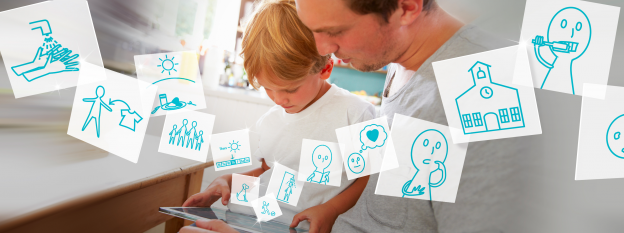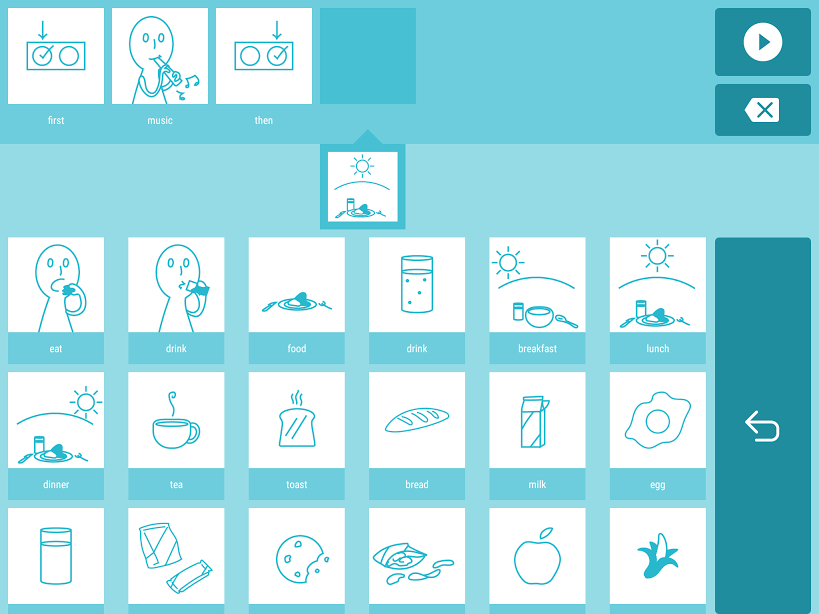
Products  One key feature of SwiftKey Symbols is that it factors in the time of day and day of the week so symbol predictions are as accurate and personalized as possible. For example, if the child has music class on Tuesdays at 11:00 am, and has previously selected symbols during that time, these will appear as predicted symbols in the sentence strip.
SwiftKey Symbols can also be deeply customized to be even more useful; users may add their own images and categories from their device and use audio playback, a speech-to-text feature that can read out the sentence that is formed for a child who has verbal impairments.
One key feature of SwiftKey Symbols is that it factors in the time of day and day of the week so symbol predictions are as accurate and personalized as possible. For example, if the child has music class on Tuesdays at 11:00 am, and has previously selected symbols during that time, these will appear as predicted symbols in the sentence strip.
SwiftKey Symbols can also be deeply customized to be even more useful; users may add their own images and categories from their device and use audio playback, a speech-to-text feature that can read out the sentence that is formed for a child who has verbal impairments.
SwiftKey Symbols Aims to Reduce Communication Barriers with New App
Imagine someone who was non-verbal and the challenges they faced just 20-30 short years ago. In the 1980s, there were no tools to assist them with communication. Thankfully in the last 20 years, things have started to change. The first big advance was using picture exchange communication tools such as Boardmaker where children could place images on boards to explain their wants and needs. In the early 2000s, the picture exchange system was moved to digital AAC Devices such as the Dynavox. The challenge with these systems was they were expensive and very clunky and annoying to schlep around with you. The real game change was the iPad. The iPad brought affordability, mobility and a plethora of communication apps that could help with assistive and augmentative communication.Introducing SwiftKey Symbols
This year brings the latest advance in assistive communications: SwiftKey Symbols. SwiftKey Symbols is a symbol-based assistive communication app that is targeted at (but not limited to) young, non-verbal individuals with special needs. SwiftKey Symbols is a beta app available on Android devices and was developed over the course of the company's last two Innovation Week events. Currently, there are 203 symbols on the app. You can download your own images and categories to a device which can help customize your communication experience. In addition SwiftKey Symbols also offers audio playback, a speech-to-text feature that can read out the sentence that is formed for a child who has visual impairments. A lot of the current communication tools on the market are often too slow to select a particular image a child might choose. SwiftKey realized that its core prediction and personalization technology - which learns from each individual as they use it - would be a natural fit for people on the autistic spectrum who respond particularly well to routine-based activity. Although other apps make it easy to define favorites, only SwiftKey Symbols attempts to simplify finding the right symbols through machine learning prediction. The ability to provide the technology free is also a huge benefit to this community where assistive tools can be costly and inaccessible.How SwiftKey Symbols Works
Users of SwiftKey Symbols can build a sentence by choosing images, hand-drawn by a SwiftKey team member, from a set of categories or from a prediction slider powered by the SwiftKey SDK. Employing SwiftKey’s input and predictive technology, the app’s tech complements routine-based activity and learns from each individual’s behavior to surface images relevant to them quickly. One key feature of SwiftKey Symbols is that it factors in the time of day and day of the week so symbol predictions are as accurate and personalized as possible. For example, if the child has music class on Tuesdays at 11:00 am, and has previously selected symbols during that time, these will appear as predicted symbols in the sentence strip.
SwiftKey Symbols can also be deeply customized to be even more useful; users may add their own images and categories from their device and use audio playback, a speech-to-text feature that can read out the sentence that is formed for a child who has verbal impairments.
One key feature of SwiftKey Symbols is that it factors in the time of day and day of the week so symbol predictions are as accurate and personalized as possible. For example, if the child has music class on Tuesdays at 11:00 am, and has previously selected symbols during that time, these will appear as predicted symbols in the sentence strip.
SwiftKey Symbols can also be deeply customized to be even more useful; users may add their own images and categories from their device and use audio playback, a speech-to-text feature that can read out the sentence that is formed for a child who has verbal impairments.


